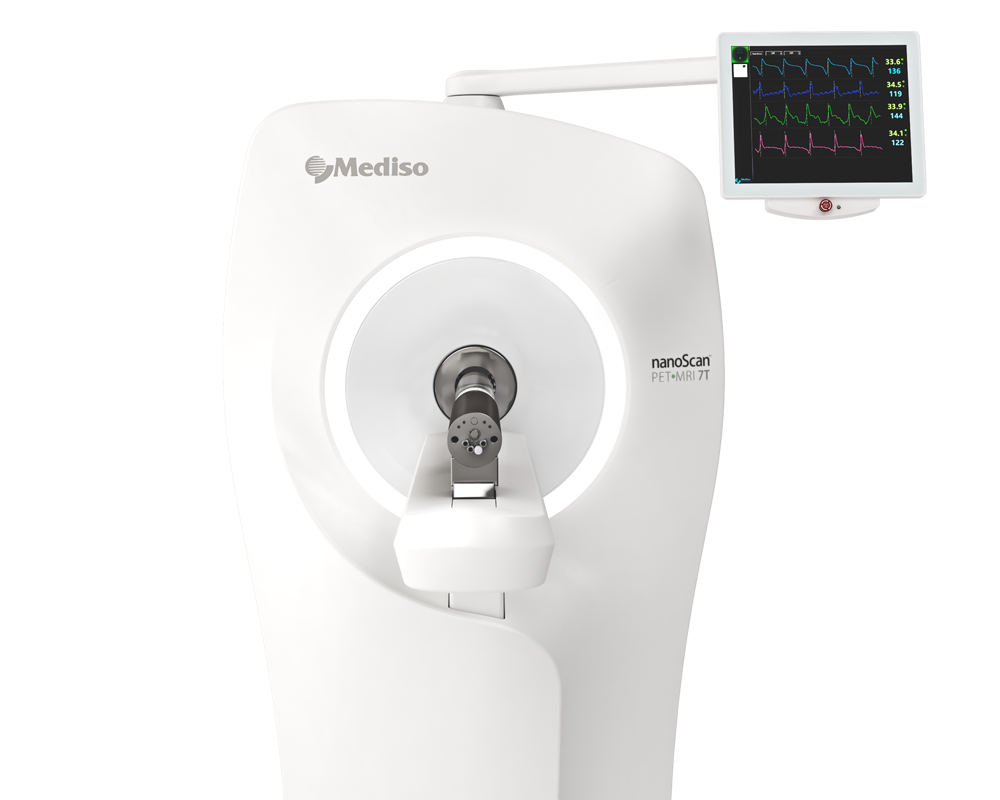Improved in vivo PET imaging of the adenosine A 2A receptor in the brain using [ 18 F]FLUDA, a deuterated radiotracer with high metabolic stability
2021.02.02.
Thu Hang Lai, Magali Toussaint et al., European Journal of Nuclear Medicine and Molecular Imaging, 2021
Summary
The signaling molecule adenosine is an important modulator of neurotransmission, regulating physiological processes such as sleep, motor activity, or sensorimotor gating. Consequently, modulating adenosine signaling is an emerging treatment option for neuropsychiatric and neurodegenerative disorders. For instance, the measurement of mRNA levels indicated a reduced A2A receptor density in the caudate and putamen of patients with Parkinson’s disease (PD), while increased A2A protein levels were found in PD patients with dyskinesias and in patients with Huntington’s disease (HD). Given that PD is characterized by a reduced mobility whereas PD patients with dyskinesias and HD patients show excessive movements, these findings collectively indicate that A2A is an important reporter - and modulator - of mobility in human basal ganglia. Accordingly, the A2A antagonist istradefylline has been approved for treatment of PD in the USA and in Japan.
Molecular imaging of the A2A receptor by means of positron-emission tomography (PET) has the potential to quantitatively assess the receptor availability and changes thereof during the course of neuropsychiatric diseases’ pathological processes and determine optimal dosing regiments for drugs targeting A2A.
The authors' group performed dynamic PET studies in a rotenone-based mouse model of Parkinson’s disease with [18F]FESCH. However, the study yielded inconclusive data, at least in part due to the penetration of a non-negligible fraction of a single radiometabolite into the mouse’ brain. Therefore, the authors intended to enhance the metabolic stability of [18F]FESCH by developing a deuterated isotopologue, FLUDA. To test the hypothesis that a selective substitution with deuterium improves the imaging properties of the novel A2A receptor–specific radiotracer [18F]FLUDA, they performed a series of preclinical animal studies including in vivo metabolism and dynamic PET/MRI investigations in mouse and dynamic PET investigations in piglets to investigate target specificity and pharmacokinetics in different species.
Results from nanoScan PET/MRI 1T
The PET/MRI scans were performed using the nanoScan PET/MRI 1T system in CD-1 mice under baseline (n = 4), control (vehicle, n = 8), and blocking (pre-administration of 2.5 mg/kg tozadenant (also known as SYN-115) or 1.0 mg/kg istradefylline (also known as KW-6002) i.v. 15 to 8 min before radiotracer n = 4, respectively) conditions. Dynamic whole-body animal PET scans were acquired during 60 min after i.v. administration of [18F]FLUDA (3.1–9.7 MBq, 0.7–4.5 nmol/kg). T1-weighted imaging was performed afterwards for anatomical orientation and attenuation correction. After reconstruction, PET images were analyzed in PMOD 3.9 (PMOD technologies LLC; Zurich; Switzerland), and volumes of interest were applied to the PET series to extract time-activity curves (TACs). TACs were expressed in standardized uptake value (SUV).
Figure 6a. shows representative PET images of [18F]FLUDA in a mouse brain. Corresponding to the in vitro autoradiography, the highest uptake was detected in the A2A receptor–rich striatum. Also, the negligible accumulation of activity in A2A receptor–poor regions, such as cerebellum, is in agreement with the in vitro data. These general findings are confirmed by the analysis of the PET-derived regional time-activity curves (TACs) presented in Fig 6b. In fact, a high specific-to-non-specific binding ratio was reached, with a maximum SUVrSt/Cb of 8.3 reflecting a high target selectivity (Fig 6c.). Furthermore, the continuous washout of activity from all brain regions confirms the absence of brain-penetrant radiometabolites. To validate the target specificity of [18F]FLUDA in vivo, the A2A receptor antagonist istradefylline (1 mg/kg) or tozadenant (2.5 mg/kg) were administered i.v. at 10 min before radiotracer injection. Maximum blocking was obtained by pre-treatment of istradefylline as reflected by the striatal SUV being similar to the cerebellar SUV under blocking conditions during the entire period of investigation (Fig. 6d–e). By tozadenant pre-treatment, the accumulation of activity in the striatum was reduced by 23.5% in comparison to the control (according to the area under the curve (AUC); AUCvehicle: 24.9 ± 8.7 SUV ∙ min; AUCtozadenant: 19.0 ± 4.3 SUV ∙ min from 0 to 60 min; Fig. S8). The activity accumulation in the cerebellum was not significantly affected by the blocking compound (Fig. 6e; AUCvehicle: 5.9 ± 3.0 SUV ∙ min; AUCtozadenant: 5.4 ± 1.3 SUV ∙ min from 0 to 60 min; Fig. S8), confirming the target specificity of [18F]FLUDA and indicating the suitability of the cerebellum as a reference region for A2A receptor imaging.

- [18F]FLUDA is a new A2A receptor–targeting PET radiotracer with promising preclinical results for clinical translation. The radiotracer can be prepared with high molar activities and in reasonable radiochemical yield (manuscript reporting automated synthesis under preparation). Highly affine and specific binding of [18F]FLUDA in vivo was demonstrated by PET studies performed in different species.
- The selective deuteration resulted in a high metabolic stability, and the identification of cerebellum as a reference region is assumed to facilitate the quantification of the availability of the A2A receptor in the brain and disease-related changes thereof in clinical routine.
- Furthermore, the results of a toxicity and a dosimetry study [29] indicate that the use of [18F]FLUDA in first-in-human imaging studies is safe.
How can we help you?
Don't hesitate to contact us for technical information or to find out more about our products and services.
Get in touch
